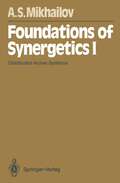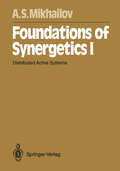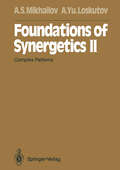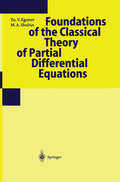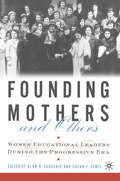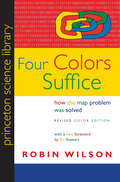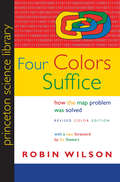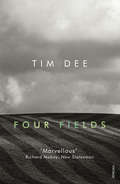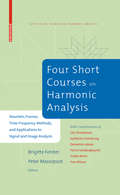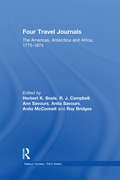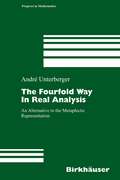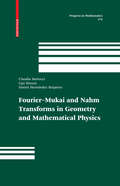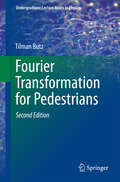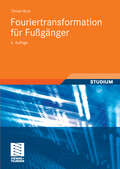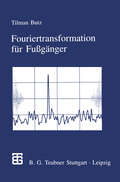- Table View
- List View
Foundations of Synergetics I: Distributed Active Systems (Springer Series in Synergetics #51)
by Alexander S. MikhailovThis book gives an introduction to the mathematical theory of cooperative behavior in active systems of various origins, both natural and artificial. It is based on a lecture course in synergetics which I held for almost ten years at the University of Moscow. The first volume deals mainly with the problems of pattern fonnation and the properties of self-organized regular patterns in distributed active systems. It also contains a discussion of distributed analog information processing which is based on the cooperative dynamics of active systems. The second volume is devoted to the stochastic aspects of self-organization and the properties of self-established chaos. I have tried to avoid delving into particular applications. The primary intention is to present general mathematical models that describe the principal kinds of coopera tive behavior in distributed active systems. Simple examples, ranging from chemical physics to economics, serve only as illustrations of the typical context in which a particular model can apply. The manner of exposition is more in the tradition of theoretical physics than of in mathematics: Elaborate fonnal proofs and rigorous estimates are often replaced the text by arguments based on an intuitive understanding of the relevant models. Because of the interdisciplinary nature of this book, its readers might well come from very diverse fields of endeavor. It was therefore desirable to minimize the re quired preliminary knowledge. Generally, a standard university course in differential calculus and linear algebra is sufficient.
Foundations of Synergetics I: Distributed Active Systems (Springer Series in Synergetics #51)
by Alexander S. MikhailovThis book gives an introduction to the mathematical theory of cooperative behavior in active systems of various origins, both natural and artificial. It is based on a lecture course in synergetics which I held for almost ten years at the University of Moscow. The first volume deals mainly with the problems of pattern formation and the properties of self-organized regular patterns in distributed active systems. It also contains a discussion of distributed analog information processing which is based on the cooperative dynamics of active systems. The second volume is devoted to the stochastic aspects of self-organization and the properties of self-established chaos. I have tried to avoid delving into particular applications. The primary intention is to present general mathematical models that describe the principal kinds of coopera tive behavior in distributed active systems. Simple examples, ranging from chemical physics to economics, serve only as illustrations of the typical context in which a particular model can apply. The manner of exposition is more in the tradition of theoretical physics than of mathematics: Elaborate formal proofs and rigorous estimates are often replaced in the text by arguments based on an intuitive understanding of the relevant models. Because of the interdisciplinary nature of this book, its readers might well come from very diverse fields of endeavor. It was therefore desirable to minimize the re quired preliminary knowledge. Generally, a standard university course in differential calculus and linear algebra is sufficient.
Foundations of Synergetics II: Complex Patterns (Springer Series in Synergetics #52)
by Alexander S. Mikhailov Alexander Yu. LoskutovThis textbook is based on a lecture course in synergetics given at the University of Moscow. In this second of two volumes, we discuss the emergence and properties of complex chaotic patterns in distributed active systems. Such patterns can be produced autonomously by a system, or can result from selective amplification of fluctuations caused by external weak noise. Although the material in this book is often described by refined mathematical theories, we have tried to avoid a formal mathematical style. Instead of rigorous proofs, the reader will usually be offered only "demonstrations" (the term used by Prof. V. I. Arnold) to encourage intuitive understanding of a problem and to explain why a particular statement seems plausible. We also refrained from detailing concrete applications in physics or in other scientific fields, so that the book can be used by students of different disciplines. While preparing the lecture course and producing this book, we had intensive discussions with and asked the advice of Prof. V. I. Arnold, Prof. S. Grossmann, Prof. H. Haken, Prof. Yu. L. Klimontovich, Prof. R. L. Stratonovich and Prof. Ya.
Foundations of the Classical Theory of Partial Differential Equations (Encyclopaedia of Mathematical Sciences #30)
by Yu.V. Egorov M.A. ShubinFrom the reviews: "...I think the volume is a great success ... a welcome addition to the literature ..." The Mathematical Intelligencer, 1993 "... It is comparable in scope with the great Courant-Hilbert Methods of Mathematical Physics, but it is much shorter, more up to date of course, and contains more elaborate analytical machinery...." The Mathematical Gazette, 1993
Founding Mothers and Others: Women Educational Leaders During the Progressive Era
by A. Sadovnik S. SemelInterest in progressive education and feminist pedagogy has gained a significant following in current educational reform circles. Founding Mothers and Others examines the female founders of progressive schools and other female educational leaders in the early twentieth century and their schools or educational movements. All of the women led remarkable lives and their legacies are embedded in education today. The book examines the lessons to be learned from their work and their lives. The book also analyzes whether their leadership styles support contemporary feminist theories of leadership that argue women administrators tend to be more inclusive, democratic, and caring than male administrators. Through an examination of these women, this book looks critically at the ways in which the leaders' administrative styles and behaviors lend support to feminist claims.
Four and Six Figure Grid References (tactile)
by RnibThis is a tactile diagram for GCSE level students, across two pages. The first page shows a four figure grid reference, and the second page shows a six figure reference. Users are guided through the diagram with dotted lines for the grid, and labels along the axis.
Four Colors Suffice: How the Map Problem Was Solved - Revised Color Edition (Princeton Science Library #128)
by Robin WilsonOn October 23, 1852, Professor Augustus De Morgan wrote a letter to a colleague, unaware that he was launching one of the most famous mathematical conundrums in history--one that would confound thousands of puzzlers for more than a century. This is the amazing story of how the "map problem" was solved. The problem posed in the letter came from a former student: What is the least possible number of colors needed to fill in any map (real or invented) so that neighboring counties are always colored differently? This deceptively simple question was of minimal interest to cartographers, who saw little need to limit how many colors they used. But the problem set off a frenzy among professional mathematicians and amateur problem solvers, among them Lewis Carroll, an astronomer, a botanist, an obsessive golfer, the Bishop of London, a man who set his watch only once a year, a California traffic cop, and a bridegroom who spent his honeymoon coloring maps. In their pursuit of the solution, mathematicians painted maps on doughnuts and horseshoes and played with patterned soccer balls and the great rhombicuboctahedron. It would be more than one hundred years (and countless colored maps) later before the result was finally established. Even then, difficult questions remained, and the intricate solution--which involved no fewer than 1,200 hours of computer time--was greeted with as much dismay as enthusiasm. Providing a clear and elegant explanation of the problem and the proof, Robin Wilson tells how a seemingly innocuous question baffled great minds and stimulated exciting mathematics with far-flung applications. This is the entertaining story of those who failed to prove, and those who ultimately did prove, that four colors do indeed suffice to color any map. This new edition features many color illustrations. It also includes a new foreword by Ian Stewart on the importance of the map problem and how it was solved.
Four Colors Suffice: How the Map Problem Was Solved
by Robin Wilson Ian StewartOn October 23, 1852, Professor Augustus De Morgan wrote a letter to a colleague, unaware that he was launching one of the most famous mathematical conundrums in history--one that would confound thousands of puzzlers for more than a century. This is the amazing story of how the "map problem" was solved. The problem posed in the letter came from a former student: What is the least possible number of colors needed to fill in any map (real or invented) so that neighboring counties are always colored differently? This deceptively simple question was of minimal interest to cartographers, who saw little need to limit how many colors they used. But the problem set off a frenzy among professional mathematicians and amateur problem solvers, among them Lewis Carroll, an astronomer, a botanist, an obsessive golfer, the Bishop of London, a man who set his watch only once a year, a California traffic cop, and a bridegroom who spent his honeymoon coloring maps. In their pursuit of the solution, mathematicians painted maps on doughnuts and horseshoes and played with patterned soccer balls and the great rhombicuboctahedron. It would be more than one hundred years (and countless colored maps) later before the result was finally established. Even then, difficult questions remained, and the intricate solution--which involved no fewer than 1,200 hours of computer time--was greeted with as much dismay as enthusiasm. Providing a clear and elegant explanation of the problem and the proof, Robin Wilson tells how a seemingly innocuous question baffled great minds and stimulated exciting mathematics with far-flung applications. This is the entertaining story of those who failed to prove, and those who ultimately did prove, that four colors do indeed suffice to color any map. This new edition features many color illustrations. It also includes a new foreword by Ian Stewart on the importance of the map problem and how it was solved.
Four Degrees of Global Warming: Australia in a Hot World
by Peter ChristoffAt Copenhagen in December 2009, the international community agreed to limit global warming to below two degrees Celsius to avoid the worst impacts of human-induced climate change. However climate scientists agree that current national emissions targets collectively will still not achieve this goal. Instead, the ‘ambition gap’ between climate science and climate policy is likely to lead to average global warming of around four degrees Celsius by or before 2100. If a ‘Four Degree World’ is the de facto goal of policy, we urgently need to understand what this world might look like. Four Degrees of Global Warming: Australia in a Hot World outlines the expected consequences of this world for Australia and its region. Its contributors include many of Australia’s most eminent and internationally recognized climate scientists, climate policy makers and policy analysts. They provide an accessible, detailed, dramatic, and disturbing examination of the likely impacts of a Four Degree World on Australia’s social, economic and ecological systems. The book offers policy makers, politicians, students, and anyone interested climate change, access to the most recent research on potential Australian impacts of global warming, and possible responses.
Four Degrees of Global Warming: Australia in a Hot World
by Peter ChristoffAt Copenhagen in December 2009, the international community agreed to limit global warming to below two degrees Celsius to avoid the worst impacts of human-induced climate change. However climate scientists agree that current national emissions targets collectively will still not achieve this goal. Instead, the ‘ambition gap’ between climate science and climate policy is likely to lead to average global warming of around four degrees Celsius by or before 2100. If a ‘Four Degree World’ is the de facto goal of policy, we urgently need to understand what this world might look like. Four Degrees of Global Warming: Australia in a Hot World outlines the expected consequences of this world for Australia and its region. Its contributors include many of Australia’s most eminent and internationally recognized climate scientists, climate policy makers and policy analysts. They provide an accessible, detailed, dramatic, and disturbing examination of the likely impacts of a Four Degree World on Australia’s social, economic and ecological systems. The book offers policy makers, politicians, students, and anyone interested climate change, access to the most recent research on potential Australian impacts of global warming, and possible responses.
Four Fields
by Tim DeeIn his first book since the acclaimed The Running Sky Tim Dee tells the story of four green fields. Four fields spread around the world: their grasses, their hedges, their birds, their skies, and their natural and human histories. Four real fields – walkable, mappable, man-made, mowable and knowable, but also secretive, mysterious, wild, contested and changing. Four fields – the oldest and simplest and truest measure of what a man needs in life – looked at, thought about, worked in, lived with, written.Dee’s four fields, which he has known for more than twenty years, are the fen field at the bottom of his Cambridgeshire garden, a field in southern Zambia, a prairie field in Little Bighorn, Montana, USA, and a grass meadow in the exclusion zone at Chernobyl, Ukraine. Meditating on these four fields, Dee makes us look anew at where we live and how. He argues that we must attend to what we have made of the wild, to look at and think about the way we have messed things up but also to notice how we have kept going alongside nature, to listen to the conversation we have had with grass and fields.Four Fields is a profound, lyrical book by one of Britain’s very best writers about nature.Shortlisted for the 2014 Ondaatje Prize
Four main plant groups (large print)
by RnibThere are four images on this page showing an example of a plant from each of the four main plant groups. The main characteristics of each plant are listed to the left of its image. There is a locator dot shown, which will be at the top left of the page when the image is the correct way up. A moss is shown to the left of top centre of the page. At the top of the image is the sporophyte containing the spores that will be released to grow into new individuals. Down from this is the stalk with thin leaves growing to either side. The fern is shown on the top right. At the top of the image is one of its fronds with pinna (leaflets) growing to either side. Further down is the rhizome with a mass of small roots growing down from it. To the right of the rhizome you will find two curled-up immature fronds, ready to open up. There is a branch of a conifer shown to the left of bottom centre. Its stem goes from the top left to the bottom right of the image with shoots growing to either side. The needle-shaped leaves grow out from the shoots. Part of a flowering plant is shown on the bottom right. It is sprig of a mint plant with two flower heads with many florets (tiny individual flowers) at the top of the image. Down the page from this are three oval leaves with serrated edges, growing out to either side of the stem.
Four main plant groups (UEB contracted)
by RnibThere are four images on this page showing an example of a plant from each of the four main plant groups. The main characteristics of each plant are listed to the left of its image. There is a locator dot shown, which will be at the top left of the page when the image is the correct way up. A moss is shown to the left of top centre of the page. At the top of the image is the sporophyte containing the spores that will be released to grow into new individuals. Down from this is the stalk with thin leaves growing to either side. The fern is shown on the top right. At the top of the image is one of its fronds with pinna (leaflets) growing to either side. Further down is the rhizome with a mass of small roots growing down from it. To the right of the rhizome you will find two curled-up immature fronds, ready to open up. There is a branch of a conifer shown to the left of bottom centre. Its stem goes from the top left to the bottom right of the image with shoots growing to either side. The needle-shaped leaves grow out from the shoots. Part of a flowering plant is shown on the bottom right. It is sprig of a mint plant with two flower heads with many florets (tiny individual flowers) at the top of the image. Down the page from this are three oval leaves with serrated edges, growing out to either side of the stem.
Four main plant groups (UEB uncontracted)
by RnibThere are four images on this page showing an example of a plant from each of the four main plant groups. The main characteristics of each plant are listed to the left of its image. There is a locator dot shown, which will be at the top left of the page when the image is the correct way up. A moss is shown to the left of top centre of the page. At the top of the image is the sporophyte containing the spores that will be released to grow into new individuals. Down from this is the stalk with thin leaves growing to either side. The fern is shown on the top right. At the top of the image is one of its fronds with pinna (leaflets) growing to either side. Further down is the rhizome with a mass of small roots growing down from it. To the right of the rhizome you will find two curled-up immature fronds, ready to open up. There is a branch of a conifer shown to the left of bottom centre. Its stem goes from the top left to the bottom right of the image with shoots growing to either side. The needle-shaped leaves grow out from the shoots. Part of a flowering plant is shown on the bottom right. It is sprig of a mint plant with two flower heads with many florets (tiny individual flowers) at the top of the image. Down the page from this are three oval leaves with serrated edges, growing out to either side of the stem.
Four Points of the Compass: The Unexpected History of Direction
by Jerry BrottonA sparkling exploration of direction, by the acclaimed author of A History of the World in 12 MapsNorth, south, east and west: almost all societies use the four cardinal directions to orientate themselves, to understand who they are by projecting where they are. For millennia, these four directions have been foundational to our travel, navigation and exploration and are central to the imaginative, moral and political geography of virtually every culture in the world. Yet they are far more subjective and various – sometimes contradictory – than we might realize.The Four Points of the Compass takes the reader on a journey of directional discovery. Jerry Brotton reveals why Hebrew culture privileges east; why Renaissance Europeans began drawing north at the top of their maps; why the early Islam revered the south; why the Aztecs used five colour-coded cardinal directions; and why no societies, primitive or modern, have ever orientated themselves westwards. He ends by reflecting on our digital age in which we, the little blue dot on the screen, have become the most important compass point. Throughout, Brotton shows that the directions reflect a human desire to create order and that they only have meaning, literally and metaphorically, depending on where you stand.
Four Short Courses on Harmonic Analysis: Wavelets, Frames, Time-Frequency Methods, and Applications to Signal and Image Analysis (Applied and Numerical Harmonic Analysis)
by Ole Christensen Karlheinz Gröchenig Demetrio Labate Pierre Vandergheynst Guido Weiss Yves WiauxWritten by internationally renowned mathematicians, this state-of-the-art textbook examines four research directions in harmonic analysis and features some of the latest applications in the field. The work is the first one that combines spline theory, wavelets, frames, and time-frequency methods leading up to a construction of wavelets on manifolds other than Rn. Four Short Courses on Harmonic Analysis is intended as a graduate-level textbook for courses or seminars on harmonic analysis and its applications. The work is also an excellent reference or self-study guide for researchers and practitioners with diverse mathematical backgrounds working in different fields such as pure and applied mathematics, image and signal processing engineering, mathematical physics, and communication theory.
Four Travel Journals / The Americas, Antarctica and Africa / 1775-1874 (Hakluyt Society, Third Series)
by R. J. Campbell Herbert K. Beals Ann Savours Anita McConnell Roy BridgesThis volume offers annotated texts with biographical and historical introductions of four previously unpublished travel journals from the period 1775-1874. The first of these is the journal of a participant in a Spanish expedition sent from Mexico to explore the north-west coast of America. From the outset, difficulties plagued the voyage. Bodega's ship, a small schooner named Sonora, was not designed for open-ocean voyaging. A landing party was attacked and killed; midway into the voyage the Sonora became separated from her flagship; and later she was nearly capsized by a massive wave. Bodega's journal records the voyage's travails, hardships, discoveries, and eventual return. Next comes the journal of Commander Stokes, who served in command of HMS Beagle, under Captain P. P. King during the survey of the Straits of Magellan in 1827. This is an account of a detached operation, in very difficult weather conditions, in the western part of the strait. It is introduced by remarks on the expedition and the hydrographic history of the strait from its discovery to the inception of the survey and supplemented by remarks from Captain King's account and also that of the clerk, Macdouall. The third text is the journal of a young midshipman in HMS Chanticleer, a small vessel commanded by Henry Foster, RN, who had recently been elected a Fellow of the Royal Society for his scientific work in the Arctic. The voyage of 1828-31 was to make observations in the South Atlantic to determine the shape of the Earth and to ascertain the longitudes of a number of ports. Kay's lively diary describes the Chanticleer's encounters with warships of the Brazilian navy, largely manned by Englishmen. He records his struggle to take observations at Deception Island during gales and snowstorms, and near Cape Horn in fierce squalls and constant chilling rain, nevertheless remaining cheerful in the company of his fellow midshipmen. The final piece is the diary of Jacob Wainwright.
Four Travel Journals / The Americas, Antarctica and Africa / 1775-1874: The Americas, Antarctica And Africa, 1775-1874 (Hakluyt Society, Third Series #No. 18)
by R. J. Campbell Herbert K. Beals Ann Savours Anita McConnell Roy BridgesThis volume offers annotated texts with biographical and historical introductions of four previously unpublished travel journals from the period 1775-1874. The first of these is the journal of a participant in a Spanish expedition sent from Mexico to explore the north-west coast of America. From the outset, difficulties plagued the voyage. Bodega's ship, a small schooner named Sonora, was not designed for open-ocean voyaging. A landing party was attacked and killed; midway into the voyage the Sonora became separated from her flagship; and later she was nearly capsized by a massive wave. Bodega's journal records the voyage's travails, hardships, discoveries, and eventual return. Next comes the journal of Commander Stokes, who served in command of HMS Beagle, under Captain P. P. King during the survey of the Straits of Magellan in 1827. This is an account of a detached operation, in very difficult weather conditions, in the western part of the strait. It is introduced by remarks on the expedition and the hydrographic history of the strait from its discovery to the inception of the survey and supplemented by remarks from Captain King's account and also that of the clerk, Macdouall. The third text is the journal of a young midshipman in HMS Chanticleer, a small vessel commanded by Henry Foster, RN, who had recently been elected a Fellow of the Royal Society for his scientific work in the Arctic. The voyage of 1828-31 was to make observations in the South Atlantic to determine the shape of the Earth and to ascertain the longitudes of a number of ports. Kay's lively diary describes the Chanticleer's encounters with warships of the Brazilian navy, largely manned by Englishmen. He records his struggle to take observations at Deception Island during gales and snowstorms, and near Cape Horn in fierce squalls and constant chilling rain, nevertheless remaining cheerful in the company of his fellow midshipmen. The final piece is the diary of Jacob Wainwright.
The Fourfold Way in Real Analysis: An Alternative to the Metaplectic Representation (Progress in Mathematics #250)
by André UnterbergerFourier-Mukai and Nahm Transforms in Geometry and Mathematical Physics (Progress in Mathematics #276)
by CLAUDIO BARTOCCI Ugo Bruzzo Daniel Hernández RuipérezIntegral transforms, such as the Laplace and Fourier transforms, have been major tools in mathematics for at least two centuries. In the last three decades the development of a number of novel ideas in algebraic geometry, category theory, gauge theory, and string theory has been closely related to generalizations of integral transforms of a more geometric character. "Fourier–Mukai and Nahm Transforms in Geometry and Mathematical Physics" examines the algebro-geometric approach (Fourier–Mukai functors) as well as the differential-geometric constructions (Nahm). Also included is a considerable amount of material from existing literature which has not been systematically organized into a monograph. Key features: Basic constructions and definitions are presented in preliminary background chapters - Presentation explores applications and suggests several open questions - Extensive bibliography and index. This self-contained monograph provides an introduction to current research in geometry and mathematical physics and is intended for graduate students and researchers just entering this field.
Fourier Series, Fourier Transform and Their Applications to Mathematical Physics (Applied Mathematical Sciences #197)
by Valery SerovThis text serves as an introduction to the modern theory of analysis and differential equations with applications in mathematical physics and engineering sciences. Having outgrown from a series of half-semester courses given at University of Oulu, this book consists of four self-contained parts. The first part, Fourier Series and the Discrete Fourier Transform, is devoted to the classical one-dimensional trigonometric Fourier series with some applications to PDEs and signal processing. The second part, Fourier Transform and Distributions, is concerned with distribution theory of L. Schwartz and its applications to the Schrödinger and magnetic Schrödinger operations. The third part, Operator Theory and Integral Equations, is devoted mostly to the self-adjoint but unbounded operators in Hilbert spaces and their applications to integral equations in such spaces. The fourth and final part, Introduction to Partial Differential Equations, serves as an introduction to modern methods for classical theory of partial differential equations. Complete with nearly 250 exercises throughout, this text is intended for graduate level students and researchers in the mathematical sciences and engineering.
Fourier Transformation for Pedestrians (Undergraduate Lecture Notes in Physics)
by Tilman ButzThis book is an introduction to Fourier Transformation with a focus on signal analysis, based on the first edition. It is well suited for undergraduate students in physics, mathematics, electronic engineering as well as for scientists in research and development. It gives illustrations and recommendations when using existing Fourier programs and thus helps to avoid frustrations. Moreover, it is entertaining and you will learn a lot unconsciously. Fourier series as well as continuous and discrete Fourier transformation are discussed with particular emphasis on window functions. Filter effects of digital data processing are illustrated. Two new chapters are devoted to modern applications. The first deals with data streams and fractional delays and the second with the back-projection of filtered projections in tomography. There are many figures and mostly easy to solve exercises with solutions.
Fourier Transformation for Pedestrians
by Tilman ButzCovers Fourier transformation and Fourier series with a particular emphasis on window functions. Written for students and practitioners who deal with Fourier transformation. Including many illustrations and easy-to-solve exercises Presents serious science in an amusing way
Fouriertransformation für Fußgänger
by Tilman ButzDieses unterhaltsame Lehrbuch wendet sich an alle, die in der Ausbildung und in ihrer beruflichen Praxis mit Fouriertransformationen zu tun haben. Das Buch behandelt sowohl Fourierreihen als auch kontinuierliche und diskrete Fouriertransformationen. Außerdem werden Fensterfunktionen ausführlich diskutiert. Zahlreiche Abbildungen und Beispiele, die vom Leser meist von Hand nachgerechnet werden können, machen den Stoff leicht verständlich.
